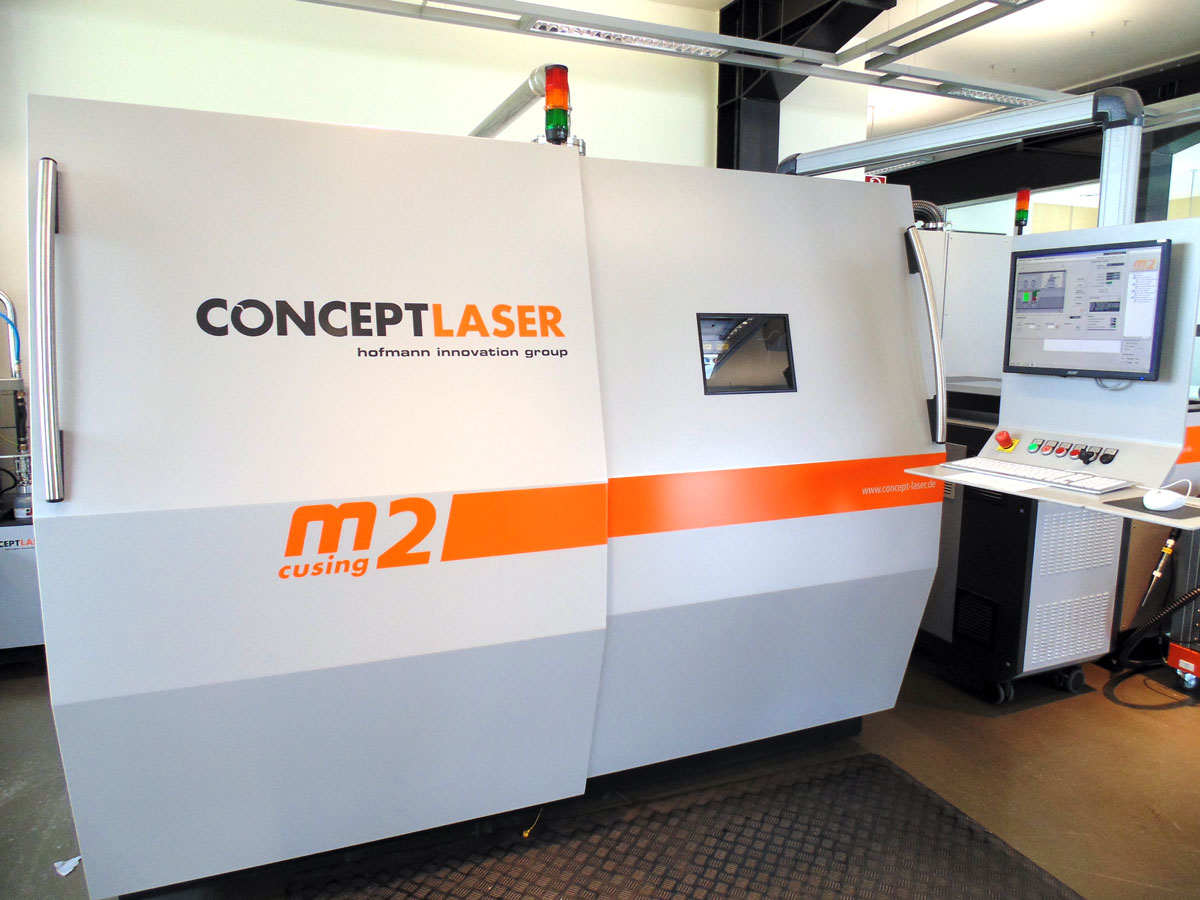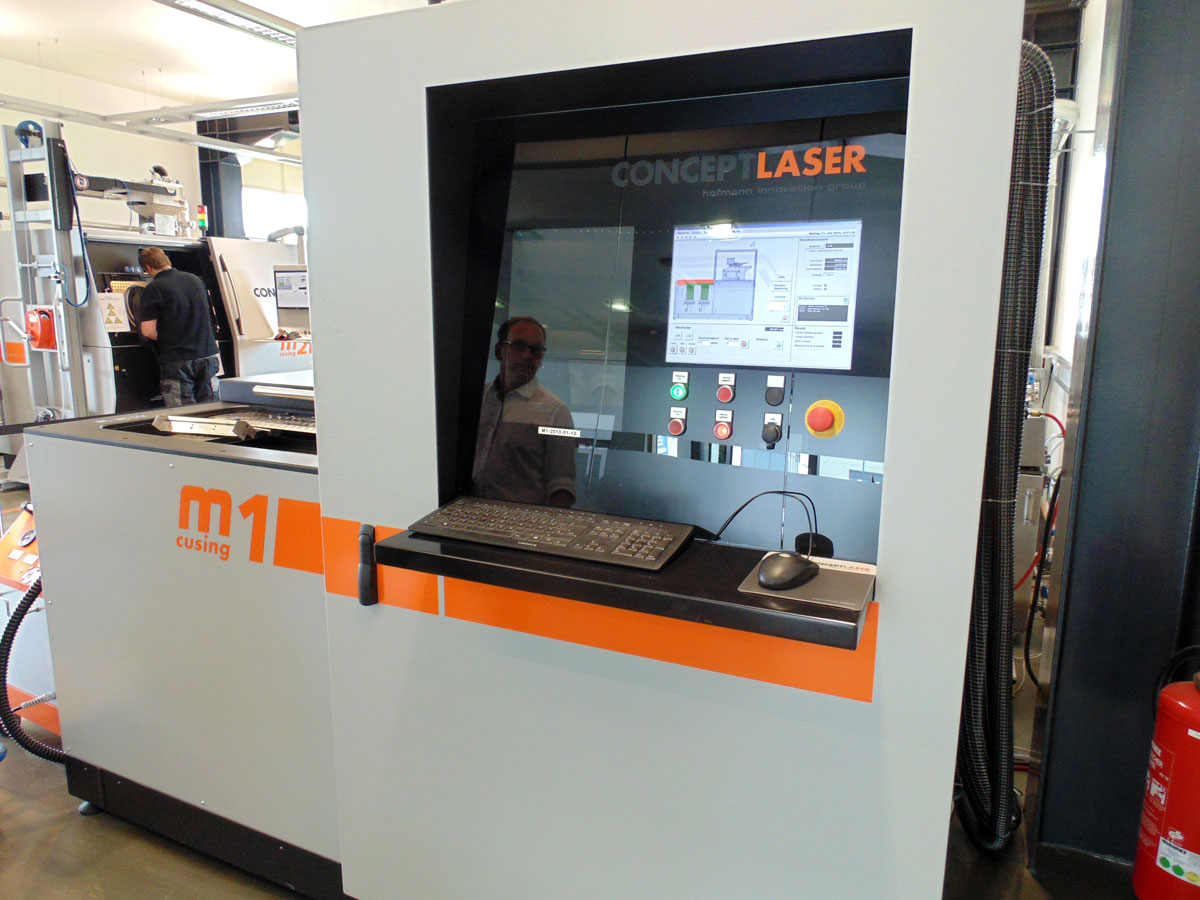Davide Sher recently had the opportunity to interview Mr Frank Herzog, founder and CEO of Concept Laser, currently the biggest manufacture of metal 3D printers in the world. Its LaserCUSING technology was the first Selective Laser Melting (SLM) process to become commercially available and – after the last few years of intense growth – it has become, by yearly revenues, the largest company within the Hofmann Innovation Group, a long standing German tool and model manufacturer. Visiting Concept Laser in person, what Davide discovered was a company far larger than he had imagined. And, perhaps even more impressive to Davide was Mr Herzog’s own success story. He began as an engineering researcher and the resulting company was based on the discoveries he and his wife made about laser melting possibilities in the 1990’s. During his visit to the new, huge, production facility being built, Herzog often said that he would never have imagined that the company could have achieved so much so rapidly. This is how it happened.
3D Printing Industry: Can you tell us a little about how LaserCUSING technology was invented?
Frank Herzog: During our studies, my wife Kerstin and I discovered that it was possible to fully melt metal powder into a three dimensional part and developed the first conceptual ideas for the LaserCUSING process. The first patent we registered was related to stochastic exposure, that is the development of the unique exposure strategy to reduce tensions in a part grown by a laser. For the first time we gave real evidence that it is possible to use lasers to build fully dense metal parts without cracks. The way we did it was by combining my own research with my wife’s expertise on lasers. At the time we were using Co2 lasers with a 10.600 nm wavelength and got parts with 30% porosity that could not allow for efficient liquid cooling channels. My wife was using a solid state laser with a 1.664 nm wavelength and we figured that might prove ideal for our objective of making the parts more dense. We ran a basic test on stainless steel powder and we eventually found that we could completely melt stainless steel. That was the turning point.
3D Printing Industry: When did you decide that you would create a company to produce and sell the LaserCUSING systems?
Frank Herzog: We then had a “full invention package” and we needed to decide what to do with it. Kerstin Herzog, my wife, is the daughter of Günter Hofmann, who founded, together with his brother, her uncle, the Hofmann Innovation Group, which has been operating in prototyping and tooling since 1958. So we turned to them and told them that we had developed the concept for a machine with removable exchange modules, where we could laser melt and remove the metal powder. And that we wanted to found a company.
3D Printing Industry: After that it was just a straight line to commercial success?
Frank Herzog: [laughs] We were explained what it means to have a company, the complexities and responsibilities that it carries. We still decided to go ahead and ‘jump into the cold water’ as they say in Germany. The Hofmann Innovation Group was our ‘business angel’. Günter and Robert Hofmann let us remain independent but were there any time we needed support, which, in the beginning, happened quite often. Once we had our investors we knew we had a year and a half to have a product ready to be shown at Euromold, so the next challenge was finding the right people to work with us. We did and, in 2001, we were the first to present a laser melting technology system, what is today called SLM or 3D metal printing. Many companies have their own patented version and in the beginning the competition was intense, as the technology was less known. Today the situation is more relaxed as demand is really high.
3D Printing Industry: How is business going today for Concept Laser?
Frank Herzog: Over the years we introduced advancements such as the QM module systems to monitor the printing process and have always been at the forefront of innovation. We like to see ourselves as pioneers and we are the current market leaders in metal 3D printing technology, though we did go through some difficult times during the 2009 global economic crisis. Since the beginning of 2010 we have been growing at yearly rates of up to 30%-40%. Much of that we owe to Oliver Edelmann, who joined the company as Head of Sales & Marketing and really helped us grow in terms of visibility and global distribution. When he arrived I was just out of the university and had never sold anything in my life. Fortunately he took care of that aspect.
3D Printing Industry: How many systems does Concept Laser sell yearly (and has sold so far)?
Frank Herzog: Today we have a couple of hundred LaserCUSING systems installed in Europe, around one hundred between the US and Asia and a couple in North Africa. In the very beginning we were selling as few as 5 machines a year and 15-17 was the norm for the early period. In the past year, though, that number was close to 100 systems and we expect a further growth of above 30%, which means we are set to sell around 120-130 systems next year. That has brought us revenues for 38 million euros in 2013, an ever more significant contribution to the entire Hofmann Innovation Group [which registers yearly revenues for 100 million euros and has over 500 employees worldwide, ed].
3D Printing Industry: Which are the sectors your systems are most implemented in?
Frank Herzog: We work with many very large companies worldwide but the most intense use of our machines is now in the dental and medical sectors. Aerospace is also very significant and almost on the same level as the first two, while automotive and even tooling – which is the sector we started from – are growing rapidly. Even the jewelry industry is becoming a very important source. At the same time it is very important with our technology to do intense research work so we have established a working relationship with close to 30 of the world’s top technological universities, including ETH Zurich, Fraunhofer, Laser Zentrum Hannover and many more. Our smaller system, the Mlab cusing, is the roughly size of a refrigerator and it is ideal to do research work although – to be honest – we did not develop it with research in mind as much as we wanted to build a professional system for small, high precision parts in the dental and jewelry industries.
3D Printing Industry: What other systems does Concept Laser’ current line up include and how much do they cost?
Frank Herzog: Out smallest system, the Mlab cusing starts at 150.000 euro. Then we have the M1 cusing, for small and medium parts, and the M2 cusing, built for safe processing of reactive materials that go from 300.000 to 400.000 euro. Our largest system is the Xline 1000R, which, depending on the options can go from 1.3 to 1.5 million euros. Usually it takes between 3 and 4 months to fulfill an order and we are already taking orders going into 2015. Right now the Xline 1000R is sold out so that might take a little while longer.
3D Printing Industry: Metal 3D printing will be growing for a while but which limits do you foresee will need to be overcome in the future to further expand the technology’s possibilities?
Frank Herzog: The biggest challenge we are facing is meeting demand, which is not a problem but simply a matter of reacting to the recent, steep increase in adoption of our systems. Technology limitations are not going to be an issue for quite some time though in the future one area where we might see improvements is productivity. That will not be an issue for at least the next 2-3 years, because when you compare the productivity of one of our machines, which can build at a rate of 100-140 cubic centimeter per hour, with a traditional tooling machine, which builds at 5 to 7 cubic centimeters per hour, it means the speed advantage is still very consistent. That said, we could double the speed in the future by adding a second laser, which is something we are certainly looking into. Laser development is so dynamic. When we started there was only one laser we could use, now there are some many to choose from, even 2 kilowatt lasers.
3D Printing Industry: Do you see a market for desktop metal 3D printing?
Frank Herzog: Do you see a market for it? In fact, the idea is quite interesting and we have taken it into consideration. The technology needs to evolve quite a bit more before that can happen at a sustainable cost.
3D Printing Industry: Which will be the primary areas for metal 3D printing adoption?
Frank Herzog: I think there will be a more widespread use in production environments for implants and the aerospace industry. Also the part produced will become larger and there will be a higher number of parts per batch with a consequent further increase in productivity. I also believe that machines will continue to become larger. That said, we now need to concentrate on the present and fulfill the demand of those sectors that are rapidly adopting our technology, while trying to maintain a focus on R&D and the study of new materials that can be used.
3D Printing Industry: That seems to always be the most determining aspect in all 3D printing. How many materials can you use and which are the biggest challenges you face in this area?
Frank Herzog: Currently we can use close to 20 different materials, including pure titanium and many different alloys. We can even do precious metals alloys of gold and silver. The possible range of materials that we could implement is virtually endless and we have our own materials scientists studying them constantly, though it does take a lot of time, money and effort to optimize each material for each machine and laser parameter. This is also become a very delicate aspect in the industry: when we release these parameters it can happen that the raw material manufactures decide to use them to market them directly to our customers, with the result that we sometime end up paying more per kg when buying 5 tons than companies that only buy 100 kg per year. Furthermore, we can only guarantee for the materials that we optimize, not for those purchased elsewhere, which might cause the part to be printed at a lesser quality and crack because it is not made to the exact specifications. The material issue is very complex – not just for Concept Laser – and we do respect our customer’s desire to be able to choose where they purchase them from. We are certainly going to find a solution that everyone will agree with.





